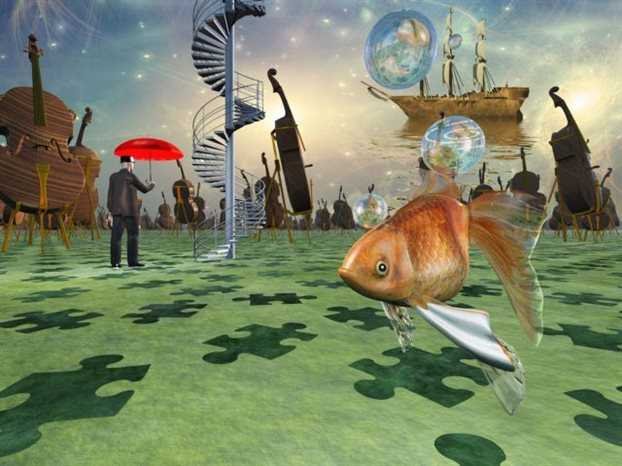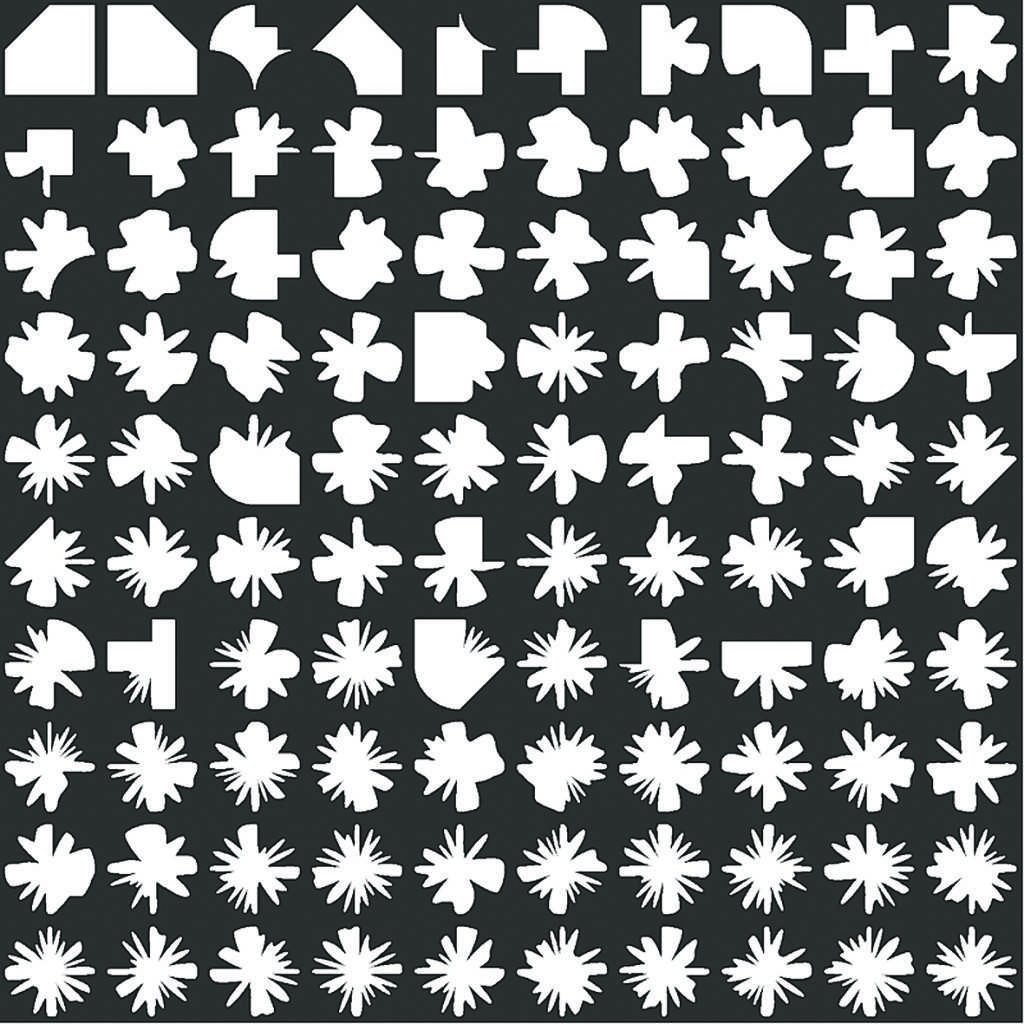Imagination is a "collective" work, as far as neurons in our brain are concerned. The scientists "saw" the network that is triggered when the imagination is being used, as well as the areas that act as "traffickers" of our attention

ΔΗΜΟΣΙΕΥΣΗ: 04/01/2014 05:45
The stepYou may think imagination is a gift that not all people have. If so, you are wrong. Even if you do not have the highly creative imagination of great writers and artists, it is certain that you use your imagination every day very often and creatively. Not only to "get away" in daydreams but also to perform many other "pedestrian" activities, such as to figure out your shopping account, find a way to prevent a door from blowing in the air, to "purge" a supposed conversation with your boss to ask for permission or raise or to think about what a friend would do in your place so you can do the same.
Αυτή η «νοητική αναπαράσταση» η οποία σας έρχεται τόσο φυσικά είναι μάλιστα μια ιδιότητα η οποία ξεχωρίζει τους ανθρώπους από τα ζώα - ή τουλάχιστον από τα περισσότερα από αυτά, όπως πιστεύουν οι ειδικοί. Δεν είναι λοιπόν τυχαίο ότι ο εντοπισμός του «κέντρου» της φαντασίας στον ανθρώπινο εγκέφαλο αποτελεί έναν από τους κύριους στόχους των ερευνών της νευροεπιστήμης. Μέχρι πρότινος ο στόχος αυτός φαινόταν μάλλον δυσεπίτευκτος, πρόσφατα όμως μια μελέτη επιστημόνων του Κολεγίου Ντάρτμουθ στο Νιου Χαμσάιρ των Ηνωμένων Πολιτειών ήρθε να δώσει την πιο «απτή» απάντηση που έχει δοθεί ως τώρα σε αυτή την
search. Οι ερευνητές όχι μόνο εντόπισαν ένα δίκτυο της φαντασίας στον εγκέφαλο εθελοντών αλλά επιπλέον μπόρεσαν να «δουν», ανάλογα με τα μοτίβα της διακίνησης των πληροφοριών, πώς ακριβώς αυτοί χρησιμοποιούσαν τη φαντασία τους - σε γενικές γραμμές τι περίπου φαντάζονταν. Πέραν του εντυπωσιακού του πράγματος, τα ευρήματά τους θεωρούνται επίσης σημαντικά γιατί προσφέρουν ισχυρή στήριξη σε μια αντίληψη που έχει αρχίσει να επικρατεί τα τελευταία χρόνια στις γνωσιακές επιστήμες και στη νευροεπιστήμη σχετικά με τον τρόπο με τον οποίο λειτουργεί ο εγκέφαλός μας.
What is the "mental workplace"
But let's take things in order. As, in just a few decades, the exploration of the human brain began to become more and more "deep" thanks to the valuable help of new imaging techniques, scientists began to identify various individual "centers" and "regions" that seemed to be related to specific functions. So we started talking, e.g. for the "vision center" or the "reward center" and so on. But over time and as studies and knowledge were enriched, experts began to conclude that at least the most complex, higher functions of the brain - such as scientific, mathematical and artistic thinking or imagination - cannot be carried out in isolation. centers but require the cooperation of more regions.
Thus was born the theory of the so-called "mental workspace", an extended neural network that combines and processes information - images, symbols, memories and other mental constructs - coming from different "centers" of the brain. Although this theory sounds perfectly reasonable, the existence of this neural network has not yet found its full scientific proof. The main obstacle to its detection is posed by the fact that the methods used in the studies of the species focus on the brain activity at individual points and are not able to "capture" the processes of information distribution in the brain networks.

The brain imaging of the researchers shows that almost the whole brain is triggered for imagination
Recently, however, with the application of new techniques, some studies have begun to identify data τα οποία συνηγορούν υπέρ της θεωρίας του νοητικού χώρου εργασίας. Η δουλειά των επιστημόνων από το Κολέγιο Ντάρτμουθ θεωρείται ότι αποτελεί ένα ιδιαίτερα σημαντικό βήμα σε αυτή την προσπάθεια καθώς έρχεται να «κουμπώσει» με προηγούμενες μελέτες, προσφέροντας την πιο «χειροπιαστή» evidence that has been found to date. "Our study is part of an expanding array of elements, we are not the first to find any evidence that the mental workplace exists, but our work together with others begins to outline it" he says in "Vima" Alex Schlegel, a PhD student in cognitive sciences at Dartmouth College and lead author of the relevant article published in the "Proceedings of the National Academy of Sciences" review. "We had some ideas that the brain should have some kind of system to handle the mental representation of things with flexibility. But our findings, coupled with a number of other elements, begin to show for the first time how the brain can do so, the neural networks that are involved in such a function ".
They captured the imagination... instantly
Η καινοτομία των ερευνητών του Ντάρτμουθ έγκειται στο ότι κατόρθωσαν για πρώτη φορά να δουν τη φαντασία εν δράσει σε πραγματικό χρόνο στον εγκέφαλο των εθελοντών και να δείξουν ότι, προκειμένου να «γεννηθεί» η νοητική αναπαράσταση, διαφορετικές περιοχές επικοινωνούσαν μεταξύ τους σε ένα διευρυμένο δίκτυο. Διαπίστωσαν μάλιστα ότι η επικοινωνία μεταξύ των περιοχών άλλαζε ανάλογα με το είδος της νοητικής αναπαράστασης στο οποίο επιδίδονταν οι εθελοντές - είδαν δηλαδή ότι μπορούσαν να καταλάβουν τι φαντάζονταν οι εθελοντές μόνο και μόνο κοιτάζοντας το
motif of communication between the different areas of the network!
But to get there they had to carefully plan their experiments. “You know, we're all particularly interested in these mysterious behaviors like imagination and creativity—what makes an artist an artist, for example. But in order to approach these issues scientifically, you have to put in place many checks and make things as simple as possible." says Mr. Schlegel. For this reason, scientists chose to ask volunteers to perform three different "imaging works" as they call it. By excluding the acoustic stimuli in the laboratory and allowing only visuals, they showed volunteers a series of patterns they had designed themselves that could be synthesized into more complex imagery or "decomposed" to give simpler shapes.
The experiment
 A series of shapes that had to remember, synthesize and disintegrate the volunteers
A series of shapes that had to remember, synthesize and disintegrate the volunteersIn the first task, volunteers saw one shape for eight seconds and later had to distinguish between four different shapes - a simple working memory test, which requires the mental representation of an image. In the other two tasks, volunteers were again shown some shapes for eight seconds and later had to either put them together to make another shape or break them down into smaller pieces - think of it like trying to imagine a dog with a head lion or a headless horseman, both images require either assembling other images you retrieve from memory or disassembling them.
"These two projects required processing of the images after they had been formed in the mind" the investigator explains.
"In essence what we did have two different functions of the mental representation. And the question was: can we see when a person assembled or disassembled an image based on brain activity? And what are the areas involved in these projects? "
As scientists saw, both of these functions were not the work of some individual sites but of an entire network. "This was very interesting, that it was not just one or two parts of the brain that seemed to be involved in these functions but a network that seemed to spread across the brain" says Mr. Schlegel. “Not only that, but in some subsets of this network we could see, we could actually tell from the pattern of information flow whether a person was assembling or disassembling an image. You know, the press says about these techniques that they "read the mind". Well, we did something like that with the techniques we used". In addition, the scientists saw that the way the involved regions were connected to each other - the pattern of "connectivity" - was different from the other two when the volunteers simply recalled an image in the first simple test of working memory.
How is attention directed?
Although the mental workplace network seemed to spread across the brain, some areas seemed to be particularly involved in it. These were the frontal pre-frontal cortex and the posterior parietal cortex, two areas constituting the so-called "frontal parietal network," which is associated with higher cognitive functions such as functional memory, mathematical computations, or analogue reasoning. "One is in the frontal lobe, in the front of the brain and the other in the parietal lobe, backwards" explains Mr. Schlegel. "Too many studies are exploring these areas and we are beginning to understand what they specialize in". The parietal cortex is related to attention, which parts of one's experience one pays attention to, while the prefrontal cortex is related to the direction of the brain - it directs attention, working memory as well as many different functions and behaviors, as the scientist explains. "It seems that the frontal-parietal network is particularly involved in the flexibility of the direction of attention, sometimes it directs our attention to external stimuli, sometimes it directs it towards our inner world, the images of our mind or the functional memory".
Mysterious and admired "everyday" human qualities
The ability of the human brain to create stories and images and to "travel" to different places is unique but also "awkward" for scientists. “We don't know, we still don't know enough about it, the real core of how the brain does this kind of thing eludes us. But if you think about your own experience alone, this is something that really happens, and it happens all the time." says Alex Schlegel, adding that many different individual properties are involved in this function. One of these, as he stresses, is our ability to make comparisons and transfers. "Let's say I'm a composer of classical music and I think about my composition" he explains"I want to give, for example, the feeling that a wolf enters the scene and, to do that, I can bring to my mind pictures of the wolf and connect them with sounds that I still retrieve from my memory to make a parallel ".
This, the researcher points out, shows beyond doubt that the human brain has the ability to move with enormous flexibility to come up with a kind of common language or common representation for all things - a property also unique. "It can unite different elements and extract similarities, proportions between them. Analog reasoning is at the core of the features that make people unique " he stresses. "We say that someone is stretching his hands like an eagle, we can see common qualities in things that apparently have nothing to do with each other. And this is unique ".
Join the 2.087 registrants.








